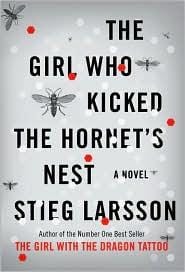The Girl Who Kicked the Hornet's Nest: Book Review & Analysis
In this in-depth review, we explore Stieg Larsson's The Girl Who Kicked the Hornet's Nest, its plot, themes, and lasting impact on modern thriller fiction.

Introduction
Stieg Larsson’s The Girl Who Kicked the Hornet’s Nest, the explosive finale to the original Millennium trilogy, delivers a satisfying blend of courtroom drama, investigative journalism, and high-stakes espionage. First published in Sweden in 2007 and translated into English in 2009, the novel continues the story of hacker prodigy Lisbeth Salander and crusading reporter Mikael Blomkvist as they confront the corrupt forces that nearly destroyed their lives. This review explores the plot, characters, themes, and cultural impact that make the book essential reading for thriller fans.
Plot Overview
The novel opens in the immediate aftermath of The Girl Who Played with Fire. Gravely wounded, Lisbeth is rushed to the hospital while her estranged father, the abusive Russian defector Alexander Zalachenko, lies in a nearby ward. The Swedish Security Service, desperate to conceal decades of illegal activity, moves quickly to silence both of them. Meanwhile, Blomkvist digs deeper, determined to prove Lisbeth’s innocence and expose the shadowy Section responsible for her lifelong mistreatment. What follows is a dual narrative: Lisbeth fights for her life and freedom inside a locked ward, while Blomkvist and the staff of Millennium magazine race against time to gather documents, persuade whistle-blowers, and publish an exposé that will topple the conspiracy. The climax unfolds in court, where Lisbeth’s legendary hacking skills and Blomkvist’s meticulous reporting finally converge to unmask the true villains.
Main Characters
Lisbeth Salander: A brilliant hacker with a photographic memory, Lisbeth embodies resilience. In this volume she evolves from fugitive to avenger, reclaiming her narrative in court and forging her own path to justice.
Mikael Blomkvist: The tenacious journalist serves as moral compass and strategic mastermind. His unwavering belief in truth underscores every investigative choice he makes.
Erika Berger: As editor-in-chief of Millennium, Erika balances professional integrity with personal loyalty, demonstrating the power of ethical journalism in a media landscape rife with spin.
Dr. Anders Jonasson & Annika Giannini: Jonasson’s medical care and Annika’s legal acumen form Lisbeth’s support network, illustrating how allies can dismantle systemic abuse.
Key Themes and Motifs
Institutional Corruption: Larsson’s novel is a scathing indictment of secret back-room deals and bureaucratic rot. By exposing how government agencies protect violent men, the story reminds readers that democracy requires vigilance and transparency.
Gender-Based Violence: Like its predecessors, the book confronts misogyny head-on. Lisbeth’s battle is not merely personal; it represents the struggle of women silenced by patriarchal systems. The detailed courtroom scenes force society to reckon with how easily victims are re-victimized.
Power of Journalism: Blomkvist’s investigation underscores the transformative effect of free press. In an era of rampant disinformation, the novel’s faith in fact-checked reporting feels both nostalgic and urgent.
Redemption and Self-Determination: Lisbeth’s journey culminates in a reclaiming of agency. Where previous installments showed her on the run, here she dictates the terms of her future, buying an apartment, reconnecting with her twin, and legally regaining autonomy over her finances.
Writing Style and Pacing
Larsson combines meticulous procedural detail with propulsive action, a juxtaposition that rewards patient reading. Technical explanations of Swedish law, hospital routines, and digital forensics build authenticity without stalling momentum. Sentence structures are clean and direct, allowing complex subplots to interweave effortlessly. The pacing accelerates toward the climactic trial, where rapid-fire dialogue and carefully planted evidence converge. Despite the novel’s length, few chapters feel extraneous; each subplot circles back to the overarching theme of systemic abuse of power.
Adaptations and Cultural Impact
The Swedish film adaptation, released in 2009 and starring Noomi Rapace, distilled the novel’s dense narrative into a tense cinematic experience, while the 2011 English-language adaptation plans highlighted Hollywood’s recognition of Salander as a modern pop-culture icon. Beyond film, the book spurred academic papers on gender politics, inspired cybersecurity conferences to reference “Salander-style” hacking, and sparked global interest in Scandinavian noir. Its influence is evident in contemporary thrillers that pair investigative journalism with social critique, from television series like Sharp Objects to novels such as The Silent Patient.
Why You Should Read It Today
More than a decade after publication, The Girl Who Kicked the Hornet’s Nest remains startlingly relevant. Conversations about governmental overreach, data privacy, and violence against women dominate today’s headlines, and Larsson’s narrative offers both cautionary tale and blueprint for resistance. Readers who value strong, multifaceted female protagonists will find Lisbeth’s arc empowering, while fans of investigative thrillers will relish Blomkvist’s journalistic rigor. Even if you have seen the movies, the book’s granular detail, psychological nuance, and subplots surrounding secondary characters provide a richer, more immersive experience.
Final Thoughts
Stieg Larsson’s swan song succeeds on multiple fronts: as a gripping thriller, a social commentary, and a character study of one of modern fiction’s most compelling heroines. By weaving together hospital corridors, newsroom chaos, and courtroom showdowns, the author crafts a multifaceted narrative that scrutinizes power from every angle. For newcomers, the novel serves as a satisfying conclusion to the Millennium saga; for returning fans, it offers deeper appreciation of Larsson’s commitment to justice. Either way, The Girl Who Kicked the Hornet’s Nest earns its reputation as a cornerstone of contemporary crime literature.



